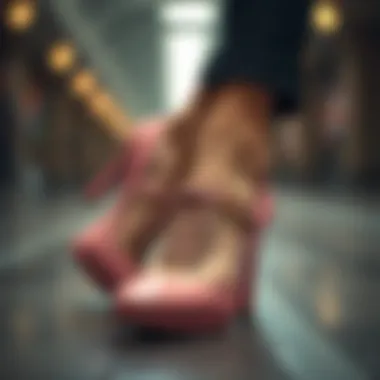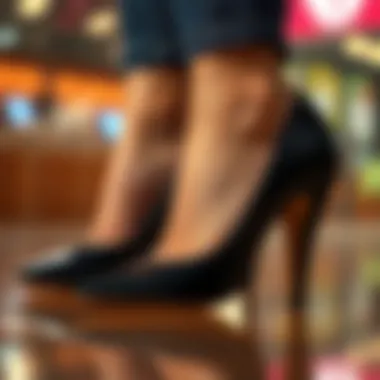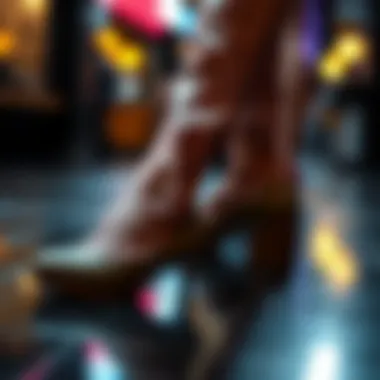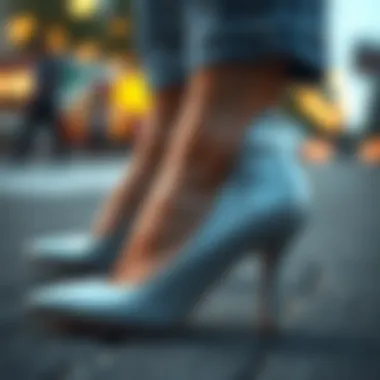Addressing Loose Heels in Footwear for Comfort


Intro
Finding that perfect pair of shoes can sometimes feel like looking for a needle in a haystack, especially if the shoes are loose in the heel. This common issue doesn’t just impact your style; it can also strike a blow to your comfort and foot health. Shoes that slip at the heel can lead to a host of problems, from blisters to misaligned posture. Understanding why this imbalance occurs and what you can do about it is crucial for anyone who values both appearance and comfort.
In this article, we’ll tackle the various factors that contribute to a poor heel fit, giving you the tools to identify the right footwear and make informed selections in the future. We’ll dive into the importance of choosing the right footwear, the signs of ill-fitting shoes, and practical solutions to remedy your loose heel plight.
From style-conscious fashionistas to discerning retailers, everyone can benefit from insights into shoe fit. The road to happy feet starts here, so let’s lace up and explore the world of footwear that may just be causing you more grief than style.
Foreword to Shoe Fit Issues
When it comes to footwear, the significance of proper fit cannot be overstated. Shoes that fit well not only enhance comfort but also play a crucial role in maintaining foot health. A poor fit, particularly shoes that are too loose in the heel, presents several challenges that can affect your daily life. In this section, we will explore why understanding shoe fit issues is essential, delving into the specific elements, benefits, and considerations surrounding this important topic.
The Importance of Proper Fit
Properly fitting shoes can be likened to finding the right piece of clothing; they should work in harmony with your body. When shoes fit well, they can prevent discomfort, reduce the risk of injury, and provide support where it's needed most. A shoe that slips in the heel can lead to a domino effect of issues:
- Discomfort and Pain: Loose heels often rub against the back of the foot, causing blisters or pain that makes walking a chore rather than a pleasure.
- Altered Gait: When feet aren’t secure, it can affect how you walk and run. This change in gait can, over time, lead to other joint problems.
- Psychological Impact: An ill-fitting shoe can undermine confidence, adversely affecting how a person presents themselves in social and professional environments.
Taking the time to ensure the right fit early on can prevent these issues down the line. One should consider factors such as foot shape, arch height, and personal walking habits when selecting shoes.
Common Fit Problems in Footwear
Navigating the world of shoes can be tricky, as many people are unaware of the common fit problems that often arise. Addressing these issues requires keen observation and understanding. Here are several fit dilemmas that shoe-wearers frequently encounter:
- Loose Heels: This is the focal point of our discussion, and it often stems from poor design or incorrect size selection, leaving the heel area feeling unanchored.
- Narrow Width: Shoes that are too narrow may pinch the sides of the foot, leading to discomfort, especially on long walks.
- Insufficient Arch Support: Without adequate arch support, individuals may experience fatigue or pain in their feet, especially after extended wear.
- Toe Box Issues: Whether too tight or too loose, the toe box can lead to a host of problems, including cramped toes or unnecessary movement that can cause blisters.
Many individuals might only become aware of fit issues after prolonged use. Recognizing these patterns is key in making informed footwear choices and ultimately achieving the comfort and style desired.
Analyzing Loose Heels in Shoes
When it comes to footwear, making sure your shoes fit properly is crucial for overall comfort. One of the most common issues is loose heels. This topic deserves a thorough examination, because loose heels can lead to discomfort, affect your posture, and even result in injuries over time. Getting to grips with this issue not only helps you choose the right footwear but also encourages informed decisions when shopping.
Identifying when a shoe's heel is too loose is the first step toward selecting better-fitting options. To tackle the challenges posed by loose heels, understanding the classification of the problem is key. Many people may not realize that the size of the heel cup and how it hugs the back of your foot can significantly impact how well a shoe fits. Furthermore, there are varying levels of heel slip some may overlook, from slight movement during a casual stroll to problematic slippage when engaging in more vigorous activities.
So, why does this matter? Firstly, a good fit matters a great deal in your daily life. Shoes that don’t fit well can change the way you walk and move, leading to discomfort and eventually to further complications like pain in your feet, knees, or back. The intricate relationship between shoe fit and overall body mechanics cannot be understated. This section seeks to shine a spotlight on the signs of loose heels and delve into what's behind this fit issue.
Defining the Issue of Loose Heels
Loose heels can be defined as any sensation where the heel of the foot does not secure adequately within the shoe. This can express itself through noticeable slippage when walking or standing. Many people might assume this only happens with oversized shoes, but that’s not always the case. Even shoes that are labeled as your correct size can sometimes have a fit that isn’t snug around the heel.
Why should you pay attention to loose heels? Because they can impact not just comfort, but the very way you maintain your balance. It can feel frustrating to be constantly adjusting your footwear or, worse yet, to switch shoes because of heel-slap.
Causes of Loose Heel Fit
Several factors contribute to a loose heel fit, affecting both how the shoe is structured and how your foot interacts with it. Common factors include:
- Shape of the Foot: Everyone's foot is a unique shape. Some folks may have higher arches, others may have wider feet, and that variance can translate into fit issues. If the shoe is not designed to accommodate your foot shape, you might experience slipping in the heel.
- Shoe Construction: The way a shoe is made plays a significant role. Shoes with more rigid materials might not offer the necessary compression around the heel. In certain cases, softer materials may lead to stretch over time, worsening an already loose fit.
- Wear and Tear: It's important to keep track of the age of your shoes. Old footwear may start to lose its firmness and elasticity, leading to a looser fit.
- Sock Thickness: The type of socks you wear can influence heel fit. Thick socks can sometimes take up space, creating a snug fit, while thin socks can allow for movement, thus making loose heels more apparent.


In summary, diagnosing loose heels and understanding the underlying causes is essential for selecting the right shoes. Becoming knowledgeable about shoe fit and the characteristics of your feet can lead to more informed purchasing decisions. For further insights about footwear and how fit can affect walking mechanics, check out sources like Wikipedia or visit Footwear News. This backdrop lays the groundwork for further strategies to remedy loose heel issues in forthcoming sections.
Impact of Loose Heels on Comfort and Functionality
Loose heels can be a real thorn in the side for anyone who cares about the comfort and functionality of their shoes. When the heel area of a shoe does not fit snugly, it can lead to several problems, not just uncomfortable walking. This section dives into why understanding these impacts is crucial, especially for those eager to maintain both style and foot health.
Effects on Gait and Posture
A shoe that doesn’t fit well can act like a wrench in the well-oiled machine of our walking mechanics. Ideally, when we take a step, the heel should firmly secure the foot, allowing for a controlled transition from heel strike to toe-off. However, with loose heels, there's a tendency for the foot to slide, forcing a change in how we walk. This alteration can lead to a number of gait abnormalities, such as overstriding or limping, and ultimately mess with overall posture.
- Poor Alignment: Without proper heel support, the body can’t maintain its natural alignment. This can lead to misalignment of the spine, hips, and knees. And let’s face it, no one wants to literally walk around like a question mark.
- Muscle Compensation: To counteract the instability, other muscles must compensate. This can lead to muscle fatigue and even chronic pain. Why? Because the body is not designed to work in a way that sidesteps the established biomechanics when the heel area is too loose.
The bottom line is that good shoes not only support our feet but also our entire bodies. Keeping those heels snug can protect against cascading issues in gait and posture, making it an essential consideration in footwear selection.
Potential for Blisters and Injuries
Those loose heels are not just an annoyance; they can invite a whole host of foot problems, particularly blisters and injuries. The friction caused by a shoe that slips with each step can create hot spots on the skin. For the uninitiated, these hot spots can quickly escalate to blisters, which can make wearing shoes a painful ordeal.
- Friction Causes Damage: It’s not rocket science—friction creates wear. When shoes move against the foot, it’s like a slow grind away at the skin's barrier. Blisters often form when there are extended periods of this friction.
- Increased Risk of Injuries: Beyond blisters, loose heels can make you prone to other injuries. Think sprains or strains. If the shoe doesn’t fit well, your foot may roll in ways it shouldn’t during walking or running, increasing the risk of ankle injuries.
In summary, while shoes might look fabulous, a loose heel can turn even the trendiest pair into a disaster zone for your feet. Understanding these potential pitfalls emphasizes why attention to fit is not just a matter of comfort but safeguarding against serious injuries.
Remember, loose heels can turn your stylish shoes into sources of discomfort and pain. Keep your footwear tight for health and happiness!
Identifying Signs of Ill-Fitting Shoes
Knowing how to spot signs of ill-fitting shoes is crucial, especially when you’re dealing with loose heels. If your shoes don't fit well, they can lead to discomfort and even injury, which is far from ideal when you're trying to strut your stuff. The stakes are particularly high if you're a fashion enthusiast or a professional stylist, as shoe fit isn't just about comfort—it's about aesthetics, too. Awareness of these signs helps in making informed decisions, ensuring you always have the right footwear that not only looks good but feels good.
Visual Indicators to Look For
A keen eye can pick up various visual cues that indicate a shoe may not fit correctly, particularly around the heel area. Here are some things to keep an eye on:
- Gaping Around the Heel: A noticeable gap between your heel and the back of the shoe suggests the fit is off. This space can signal either that the shoe is too big overall or that it lacks the structure to hold your foot properly.
- Wrinkling of Material: If you see the material of the shoe creasing or folding excessively when you walk, that’s a clear warning sign. It typically means the shoe is too loose and isn't wrapping your foot securely.
- Sole Wear Patterns: Inspect how the soles are wearing down. If the outer edge is wearing more than the inner part or vice versa, it might indicate your foot isn't positioned correctly in the shoe, often making for an uncomfortable wear.
- Heel Slippage: When walking, if you can see the shoe visibly lifting away from your heel with each step, this is a definite red flag. Shoes should hug your heel snugly without constricting it.
"An overlooked aspect of shoe comfort can lead to an uncomfortable walk and even long-term issues with your feet."
Physical Symptoms and Discomfort
While visual discrepancies are a solid indicator, here are some physical signs that might clue you into a poor fit, particularly in terms of heel support:
- Blisters and Friction: If you’re finding blisters forming on your heels or areas where the shoe doesn’t rub properly, this is a clear sign that the fit isn’t optimal. Loose shoes can cause excessive movement, leading to skin irritation.
- Arch Pain: A shoe that isn’t effectively gripping your heel may lead to compensatory movements, resulting in strain on your arch. Arch pain can often manifest over time and may not be obvious until it becomes chronic.
- Pinching or Numbness: Conversely, if your shoe pinches your heel or causes numbness, this could mean it’s too tight elsewhere. A shoe that fits well should feel snug but not restrictive.
- Soreness in the Foot: If your feet feel fatigued or sore after a short period of wearing the shoes, it’s time to analyze the fit. Shoes that slip at the heel can lead to awkward gait mechanics, placing undue stress on your muscles and joints.
Understanding these indicators allows individuals to be proactive about footwear choices, ultimately leading to a significantly more comfortable and secure fit. The best combination of style and comfort lies in shoes that provide a snug hold without compromising the foot's natural movement.
Strategies for Adjusting Loose Heels
Finding shoes that fit just right can be like searching for a needle in a haystack. Particularly for those dealing with loose heels, the challenge can feel particularly daunting. This section will delve into various strategies that can help reclaim the snug fit one desires. Understand that adjusting loose shoes is not merely about comfort; it's also about preventing the long-term consequences of ill-fitting footwear.


Insoles and Heel Grips
Using insoles and heel grips can greatly transform the fit of your shoes. Insoles, which are designed to fill excess space within the shoe, provide additional cushioning and support. They can help keep your foot from sliding backward, ensuring stability. Options range from basic foam inserts to specialized orthotic insoles designed for arch support. It's essential to evaluate your specific foot needs; a trip to a podiatrist might provide tailored recommendations that result in significant comfort improvements.
Heel grips, on the other hand, are strips of padding designed to adhere to the inside back of the shoe. They effectively cushion the heel, reducing movement and friction that can lead to blisters. Most heel grips are made from soft silicone or fabric, and they often come in various shapes and sizes, allowing for personalized solutions.
Choosing the Right Sock Thickness
Socks might seem like a minor detail in the grand scheme of footwear, but choosing the right thickness can make or break the fit of your shoes. Thicker socks can fill in extra space, gripping your foot more securely. Merino wool or plush cotton blends can provide warmth as well as bulk. On the other hand, lighter socks can cause movement in shoes that are already loose, emphasizing the need to take into account both the shoe's fit and the sock's thickness.
It's vital to also consider the shoe type. For instance, if you're wearing athletic shoes, a thicker sport sock may enhance your comfort, whereas, for more delicate footwear, a thinner dress sock would likely be the wise choice. Ultimately, experimenting with various sock options is worth the effort, as it can lead to a more enjoyable wearing experience.
Using Tongue Pads for Better Fit
Tongue pads serve as an often-overlooked accessory that can significantly enhance the fit of loose shoes. Placed on the tongue of the shoe, they create a tighter fit across the top of the foot. This adjustment holds the foot firmly in place and minimizes heel movement. These pads are not only easy to apply, but they also offer a great way to customize the fit of a variety of shoe types, from sneakers to formal shoes.
When choosing tongue pads, consider the materials—some are made of soft foam, while others are high-durability silicone. Testing different types will help determine which material feels most comfortable against the skin and suits your footwear variety.
In summary, adjusting loose heels is all about personalization. Everyone's foot is unique, so the tools used to achieve an adequate fit must correspond to individual requirements. Whether it’s exploring the use of insoles, experimenting with sock thickness, or adding tongue pads, these strategies can lead to a more enjoyable experience with your footwear. Stay proactive and attentive to your foot health; it pays off in the long term.
Consulting Professionals for Footwear Issues
When it comes to finding shoes that fit just right, some may think they can wing it. However, consulting professionals for footwear issues can make a world of difference. Often, individuals wrestle with loose heels, causing discomfort and a sense that shoewear just isn’t quite right. Professionals, be it podiatrists, specialized shoe retailers, or orthotic experts, can provide insights into what exactly is going on with our footwear choices and the subsequent effects on our feet.
Seeking out expert advice has specific benefits. Firstly, professionals have trained eyes and years of experience. They can evaluate your foot structure and gait, understanding exactly why a shoe might not fit properly. This isn't merely about aesthetics; it's a matter of comfort and health too. Shoes that slip can lead to blisters, calluses, and even longer-term foot problems. It's a clear case of preventing issues before they escalate.
Considerations also play a role in when or how to consult a professional. Finding the right time is key; don't wait until discomfort reaches a breaking point. It’s better to address the problem while it’s small rather than letting it grow into something larger.
"An ounce of prevention is worth a pound of cure."
Understanding when to seek professional help can save you from needless frustrations.
When to Seek Professional Help
You might find yourself asking whether a trip to a shoe specialist is warranted. Recognizing early signs is crucial. If you notice your shoes continually slipping at the heel, or you’ve come to rely on thick socks just to keep them on, it's a red flag. Foot discomfort during or after walking suggests it's time for an evaluation.
Additionally, persistent blisters forming near the heel can be a glaring sign that something needs changing. Do not overlook any other unnecessary stress on your feet, like soreness or pain.
Moreover, if you've invested in several remedies—such as insoles or pads—and yet the problem lingers, professional guidance can offer a fresh perspective. Rather than throwing darts in the dark, let someone who knows the terrain direct you.
Role of Footwear Specialists
Footwear specialists are invaluable allies in the quest for the right fit. They come equipped with expertise tailored to your unique foot needs. Unlike general salespeople, these professionals focus solely on footwear, honing their skills on aspects like arch support, heel height, and materials that suit different needs.
Their role extends beyond mere sales; they assess the nuances of how different brands fit and can guide you toward options that accommodate specific foot shapes. It’s not just about finding shoes that look good; it’s about ensuring every step you take is comfortable.
Many specialists also consider your lifestyle when recommending shoes. If you’re often on your feet for long stretches or have specific activities in mind, they can steer you in a beneficial direction.


Combining their knowledge with your insights about what hasn’t worked can lead to finding the right shoe solutions. Not only do they pinpoint fit issues effectively, but they can also suggest upgrades, like orthotics or specific shoe styles that account for your heel shape and foot width.
In sum, don’t hesitate to tap into the expertise of professionals. It can be a transformative step towards achieving footwear that fits like a glove, all while safeguarding your foot health.
Long-Term Solutions for Better Shoe Fit
Finding the right fit in footwear is crucial, particularly when grappling with loose heels. A long-term solution isn’t just a quick fix but a fundamental approach to ensure that shoes not only feel good but also support foot health over time. Embracing better shoe fit strategies can save you from discomfort, injury, and even financial waste from buying shoes that never quite work. Understanding how to attain this better fit involves more than just trial and error; it encapsulates a thoughtful consideration of your footwear choices and personal foot characteristics.
Investing in Custom Footwear
When off-the-shelf shoes simply don’t do the job, custom footwear might be the way to go. Custom-made shoes are designed to meet the unique contours of your feet. This means paying attention to not just the length but the overall shape, arch type, and heel width. If you often find that shoes are too loose around the heel, a pair tailored specifically to your feet can eliminate the problem altogether.
In addition to eliminating heel slippage, custom footwear offers better overall support and comfort. You can also creatively incorporate personal style, ensuring your shoes are as fashionable as they are functional. Consulting with a podiatrist or footwear specialist can provide insight into what specific characteristics your custom pairs should have, serving you well in the long term.
Understanding Different Shoe Shapes
Not every shoe shape fits every foot. The world of footwear is tangled up in various lasts—the mold around which shoes are formed. Understanding your own foot shape can help you pick shoes that fit more snugly at the heel. For example, those with high arches may need shoes that have a build allowing for a better grip around the heel, while individuals with wider feet might need more room in both the length and width dimensions.
- Narrow fit: Ideal for those with slimmer feet who find standard widths too loose.
- Wide fit: Perfect for those with broader foot shapes that often feel pinched in regular shoes.
- Curved fit: Suitable for those whose feet possess a more pronounced arch, tackling the heel loose issue efficiently.
By familiarizing yourself with these shapes, you’re better equipped to make educated choices, particularly when looking to avoid slipping heels.
The Importance of Trying Before Buying
This may sound obvious, but actually trying on shoes can be the most significant step in ensuring better fit. Your foot can change over time due to various factors such as aging or even lifestyle changes. Therefore, it is vital to slide your feet into different styles and brands to gauge what truly feels right.
A thorough fitting session involves more than just standing; you should walk around the store as well. Focus on how the shoes feel when you move, making sure they do not slip at the heel. Asking for assistance from knowledgeable staff can also result in discovering fits you might have overlooked.
"Taking the time to ensure the right fit is like laying a strong foundation before building a house—you don’t want it crumbling after the first storm!"
Some tips for trying on shoes:
- Always try on shoes in the time of day when your feet are at their largest, such as late afternoon.
- Wear the socks you plan to use with the shoes.
- Don’t shy away from asking questions about the dimensions and footbed.
By putting in the effort to try shoes before commitment, you can greatly enhance your chances of finding comfortable fit that remains steadfast over time.
The End and Final Thoughts
In navigating the realm of footwear, understanding how to manage shoes that are too loose in the heel is crucial. The article has taken a closer look at the myriad causes behind this issue, which often extends well beyond mere aesthetics. Loose heels can have profound implications not only on comfort but also on overall foot health and functionality. Addressing these issues fosters not just a more pleasant walking experience but can prevent future complications such as blisters, calluses, or even more severe injuries.
This guide highlighted vital strategies that can be employed to forge a more secure fit, from utilizing insoles and heel grips to making informed choices when it comes to sock thickness. Each suggested tactic underscores the importance of specificity in one’s approach to shoe fitting. Whether it’s recognizing the shoe shape that best suits an individual’s unique foot structure or opting for professional consultation, the emphasis remains on making informed choices that cater to personal comfort and fit.
Moving forward, readers should embrace the responsibility of understanding their specific footwear needs. Proper shoe fit is not merely a trivial pursuit; it’s an essential part of overall foot care. When one invests conscious thought into the selection process, they pave the way to a wardrobe that not only looks good but feels even better.
"Investing in fit now can save a world of discomfort later."
Recap of Key Points
- Importance of Fit: Shoes that fit well bring forth comfort and avoid unnecessary complications.
- Indicators of Loose Heels: Recognizing both visual and physical signs can alert you to potential issues before they escalate.
- Adjusting Strategies: Various solutions such as insoles, heel grips, and the correct selection of socks can significantly improve fit and comfort.
- Professional Guidance: Sometimes, enlisting help from specialists is the wisest course of action.
- Long-term Considerations: Opting for custom footwear or understanding diverse shoe shapes can lead to better fits in the future.
Encouragement for Informed Choices
Prioritizing informed choices when it comes to footwear pays off in more ways than one. A good pair of shoes not only complements one’s style but also supports daily activities. As fashion enthusiasts, stylists, and retailers, the objective should be a union of aesthetic appeal and practical function.
Research shows that when people feel good about their footwear, their confidence soars. Whether stepping out for work or play, choosing shoes that fit correctly is an investment in overall well-being.
In the end, don’t just settle for a pair of shoes because they catch the eye. Delve deeper into what they offer in terms of fit and comfort, and remember that your feet deserve to be treated with care. Taking the time to evaluate how shoes complement your individual needs is not just a smart choice—it's a crucial step towards holistic fashion.















